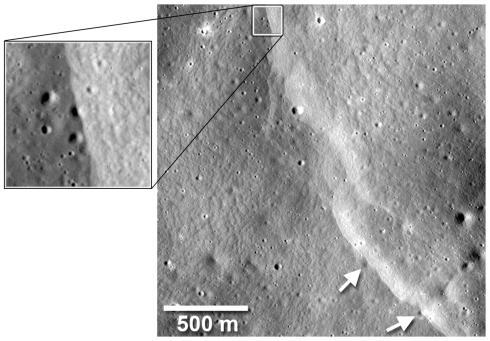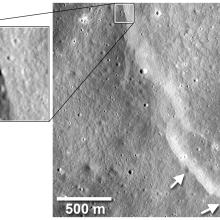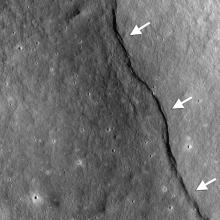
Media Inquiries
Public Inquiries
The Lunar Reconnaissance Orbiter is revealing previously undetected landforms that indicate the moon is shrinking. The findings are reported in a paper by Smithsonian scientist Thomas Watters, “Evidence of Recent Thrust Faulting on the Moon Revealed by the Lunar Reconnaissance Orbiter Camera” scheduled for publication in the Aug. 20 issue of the journal Science.
Lobate scarps, imaged by the Lunar Reconnaissance Orbiter Camera, are thrust faults that occur primarily in the lunar highlands. They were first recognized in photographs taken near the moon’s equator by the panoramic cameras flown on the Apollo 15, 16 and 17 missions. Fourteen previously unknown lobate scarps have now been revealed in very high resolution images taken by Lunar Reconnaissance Orbiter Camera. The newly detected scarps indicate that the thrust faults are globally distributed and not clustered near the moon’s equator.
"One of the remarkable aspects of the lunar scarps is their apparent young age," said Watters of the Center for Earth and Planetary Studies at the National Air and Space Museum and lead author of the paper. "Relatively young, globally distributed thrust faults show recent contraction of the whole moon, likely due to cooling of the lunar interior. The amount of contraction is estimated to be about 100 meters in the recent past."
"The ultrahigh resolution images from the Narrow Angle Cameras are changing our view of the moon," said Mark Robinson of the School of Earth and Space Exploration at Arizona State University, coauthor and principal investigator of the Lunar Reconnaissance Orbiter Camera. "We’ve not only detected many previously unknown lunar scarps, we’re seeing much greater detail on the scarps identified in the Apollo photographs."
The LRO mission is managed by NASA Goddard Space Flight Center, Greenbelt, Md. for the Exploration Systems Mission Directorate at NASA Headquarters, Washington.
The National Air and Space Museum is on the National Mall in Washington, D.C., at Sixth Street and Independence Avenue S.W. The museum’s Steven F. Udvar-Hazy Center is located in Chantilly, Va., near Washington Dulles International Airport.





